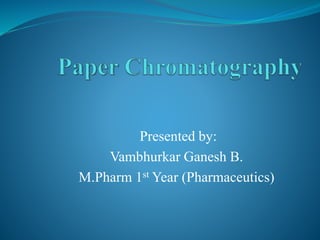
Paper Chromatography: Principles and Techniques
- 1. Presented by: Vambhurkar Ganesh B. M.Pharm 1st Year (Pharmaceutics)
- 2. Introduction: The term chromatography (In Greek ,kromatous-colour and Graphos-Written) meaning writing. -It is the method in which the component of a mixture are separated on an adsorbents. -It is method used primarily for the separation of components of a sample, in which the components are distributed between two phases , one of which is stationary while the other moves. -The stationary phase may be solid or liquid supported on a solid or a gel ,and may be packed in a column ,sprayed as a layer or distributed as a film. The mobile phase may be gaseous liquid
- 3. Classification: Partition chromatography : -This involve liquid or gas as mobile phase and another liquid as a stationary phase. Adsorption chromatography : -These involve liquid or gas as mobile phase and adsorbent solid as stationary phase .
- 4. Principle: -The principle involved in separation by paper chromatography is largely by partition coefficient phenomenon. -Separation of component depends on both their solubility in the mobile phase and their differential affinity to the mobile phase and stationary phase .
- 5. Operational technique: Choice of filter paper : -Whatman filter paper are used as chromatography . -In general this paper contains 98-99% of α-cellulose . -There are various grade and types of paper available for separation of sample. Factors that governs the choice of paper: -Nature of sample and solvent used. -Based on quantitative or qualitative analysis. -Based on thickness of paper.
- 6. Preparation of Paper : -Cut the paper into desired shape and size depending upon work to be carried out. -The starting line is marked on the paper with an ordinary pencil 2cm from the bottom edge. -On the starting line marks are made 2cm apart from each other.
- 7. Application of sample: - The sample mixture to be separated is applied as a small spot on the origin line. -The spot is dried on the filter paper and is placed in developing chamber. -Micropipette or glass capillary is used for sample application.
- 8. Solvents: A number of solvents can be used in the paper chromatography. The solvent selection depends upon nature of substance to be separated. Eg: Ethyl alcohol Benzene N-Hexane Toluene Water Chloroform These solvents are used indifferent ratio with different mixture…
- 9. Chromatographic Chamber: -The chromatographic chamber is made up of many materials like glass, plastic or stainless steel. -Glass tanks are preferred most .They are available in various dimensional size depending upon paper length and development type . -The chamber atmosphere should be saturated with solvent vapour.
- 10. Development of Chromatogram: -The paper is dipped in solvent in such a manner that the spot will not deep completely into the solvent . -The solvent will rise up by capillary action .It is allowed to run 2/3rd of paper height for better and efficient result. -After development is complete paper is taken out of the chamber carefully.
- 11. Drying of chromatogram: -The chromatogram is dried after its development . -They are dried by cold or hot air depending on volatility of solvent .A simple hair dryer is a convenient device to dry chromatograms.
- 12. Location of Spot: -If the substance are coloured they are visually detected easily . -But for colourless substance .Physical and chemical method are used to detect spot. .
- 13. Physical method: -In these method observation are done under uv light ,detection of fluorescence and radioisotope measurement
- 14. Chemical method: -In this method chemical reagent is used to develop the colour . -Amino Acid-Ninhydrin Reagent . -Alkaloids –Dragendroff’s Reagent.
- 15. Rf value: In paper chromatography the results are represented by Rf value which represent the movement or migration of solute relative to the solvent front .
- 16. Development technique: - Ascending chromatography - Descending chromatography - Ascending – Descending chromatography - Radial chromatography - Two dimensional chromatography
- 17. Ascending Chromatography: In these case the solvent migrates upward by capillary action.
- 18. Descending Chromatography: -In this method solvents moves from top to bottom so it is called descending chromatography.
- 20. Ascending –Descending Chromatography: A hybrid of above two techniques is called ascending- descending chromatography. Initial chromatography is performed ,often crossing the glass rod changes to descending.
- 22. Radial Chromatography: - These is rarely used method; in this case a circular piece of paper is taken which has a wick cut parallel to the radius from the edge to centre . -The sample is applied at the centre of the paper. The paper is then laid on the edge of circular disc with wick dipped into the solvent at the bottom of the dish
- 24. Two Dimensional Chromatography: -In this method a square paper is taken the sample is applied to the one of the corner .Using solvent system the first development is carried as ascending method . -The paper is taken out dried and second development is performed at right angle to the first dimensional development.
- 26. Application of the paper chromatography: -Used in the separation of various organic mixture. -Used for both qualitative and quantitative analysis. -Used in almost all area to solve complicated problem in chemistry, biology, biochemistry.